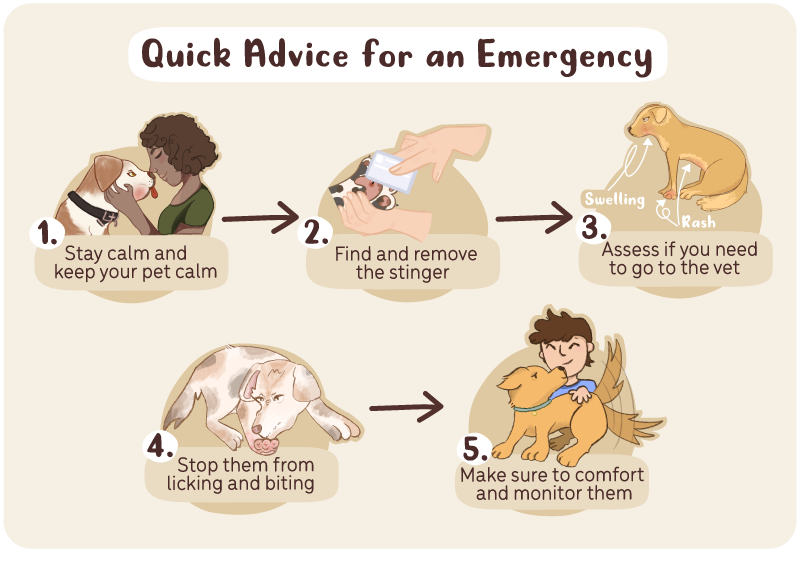My Dog Stepped on a Bee! What do I do?


What to do after a bee sting
Stay Calm, keeping yourself calm will help reassure your pup while they’re scared and in pain and will help you to remember the next steps to take.
Removing the stinger is incredibly important, if you can see the bee, check if the stinger is still in it, if not you need to find it in your dog’s paw/ skin. Once you locate it, don’t pull or pinch but gently scrape the stinger out of your dog’s skin. This can be done with either your finger or a bank card – swipe it down the skin/stinger in one direction until the stinger slides out.1
Once the stinger has been removed, placing a cold wet towel or ice pack on the area can be quite soothing to your pet and will work to distract them from licking, scratching or biting at the bee sting area. Stay with and monitor them for a few hours after the bee sting to make sure they calm down and don’t develop a reaction.1
More Information on Bee Stings For Dogs:
Are bee stings dangerous?
Generally, no, while they’re painful and annoying, they typically only cause irritation and minor symptoms your pup will easily recover from. It is, however, important to remove the stinger from your dog ASAP to remove the small amount of poison bees inject, and to relieve the irritation the stinger causes.2
What are the symptoms of a bee sting?
It’s typical to notice mild reactions such as redness and swelling to the area, whining, limping, licking or chewing at the bite. The area will be painful to the touch for a few days afterwards and you are likely to see a visible sting mark.2
When should I go to the vet?
If your dog has a known bee or bug allergy or you suspect they are having an allergic reaction, head to the vet immediately. An allergic reaction will first present with extreme swelling to the paw, face or effected area. This is typically followed by vomiting, diarrhoea, difficulty breathing, dizziness or exhaustion. You should know within 10 minutes of your dog being stung if they are having an allergic reaction, it is still important to monitor them for the hours following to ensure their symptoms don’t worsen.3
If they have sustained multiple stings or have been stung inside the mouth it is recommended to have a vet check them over to make sure all stingers have been removed, their airways are open and to reduce swelling if needed. They may require pain relief, antihistamines or anti-inflammatories for these stings.2,3
If your pup has any other underlying heath issues or is taking any other medication, it is worth giving your vet a call to discuss the interaction of a bee sting and whether you need to get them checked out.3
If you have an anxious pet, monitor their reaction and see if you can calm them at home before going to the vet for anxiety treatments. Stay with them and comfort them, distract them with their favourite toy, game or treat and offer them a cold wet towel or icepack on the area.
If your pet is not recovering from the sting, they are limping, have less energy or you’re noticing an infection, such as puss or swelling at the site, check in with your vet for treatment. Bee stings typically resolve themselves and your dog should be back to themselves within 12 to 24 hours, with a bit of TLC.2
What should I expect at the vet?
For a more serious case such as an allergic reaction, your dog may receive IV fluids, oxygen therapy, anti-inflammatories, pain relief and a stay for monitoring.3
What can you do to prevent bee stings?
Bee stings are an accident and hard to prevent, however there are a few precautions you can take:
- Check your garden and walk route for bee hives and keep your pet out of this area.
- Avoid planting flowers that attract bees.
- Practice your dog’s recall, if you see bees on your walk or in your garden, being able to call your dog away will come in handy.
- Check out some protective clothing for your pet such as a shirt or boots for their walks if you’ve noticed bees in the area.
Important Advice:
- Don’t let your dog back out into the yard after a bee sting or treatment, multiple bee stings close together increase the risk of a more severe reaction.
- Check your garden after a bee sting for any bees on the ground and remove this so your pet doesn’t step or try to eat it.
- If you’re having a beehive removed, keep your pet indoors during this and for at least 1 hour after the removal.
Sources:
Richardson, J et al. (2024). What to do if Your Dog Gets Stung by a Bee. Retrieved 12 February 2024.
Unger, J. (2022). Dog Bee Sting? Here’s What To Do. Retrieved 12 February 2024.
Lovejoy, J. (2023). What To Do if Your Dog Is Stung by a Bee. Retrieved 9 February 2024.
